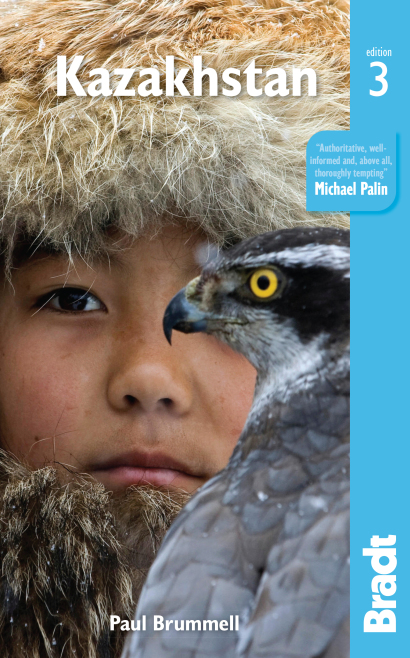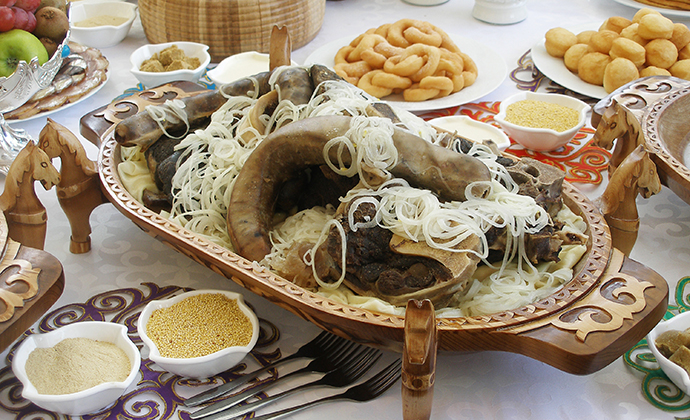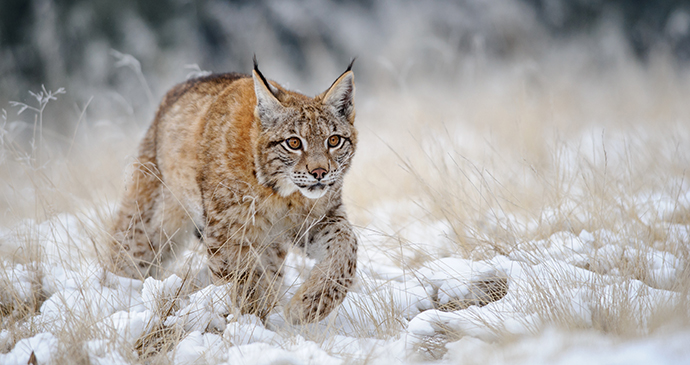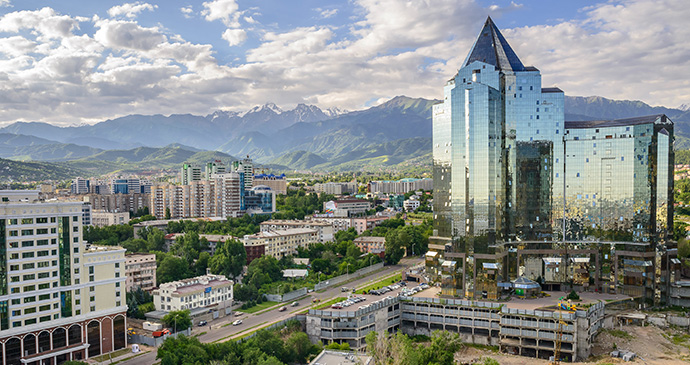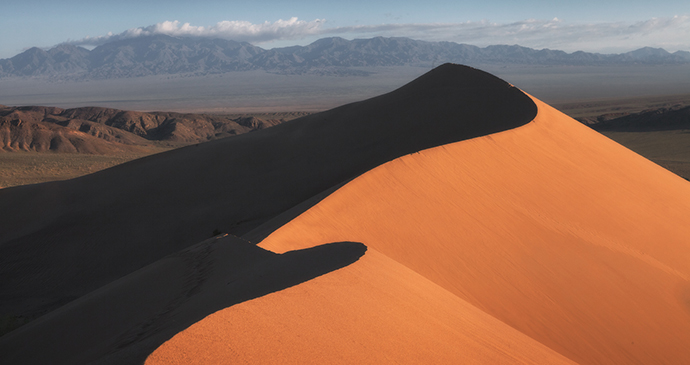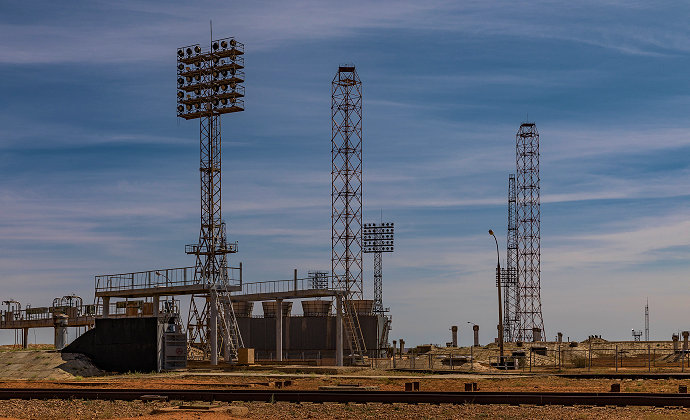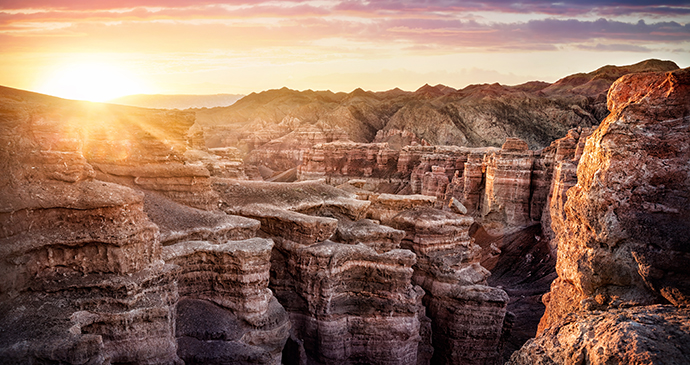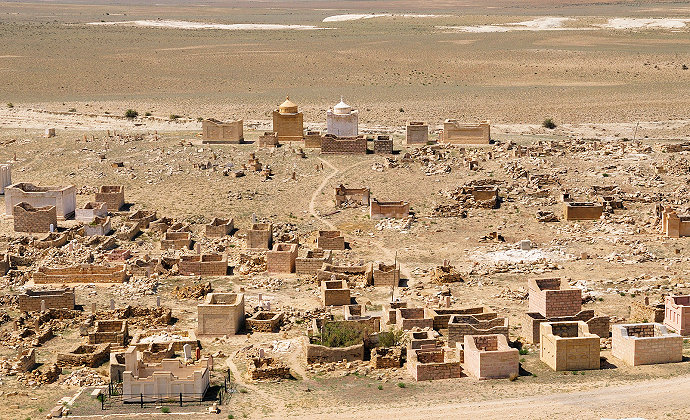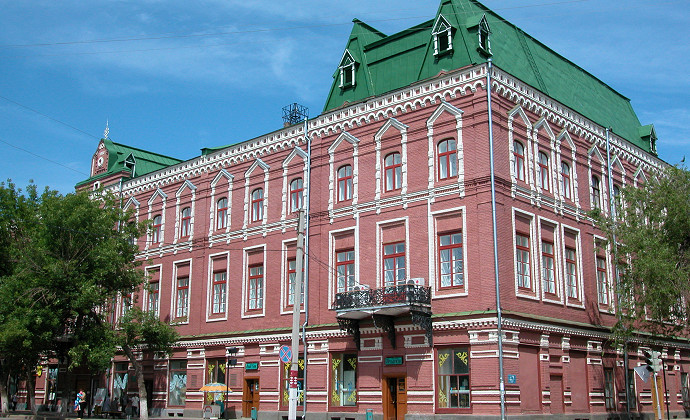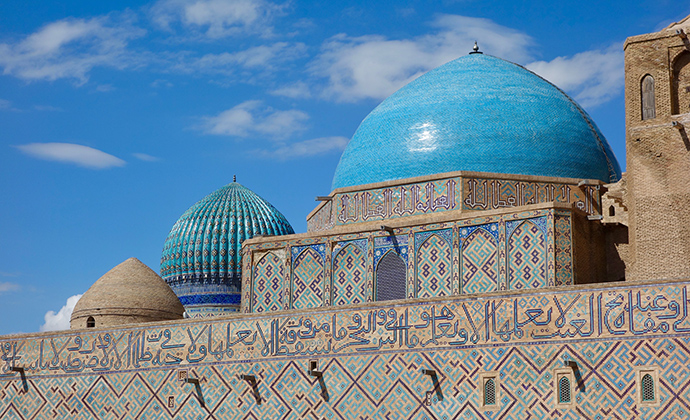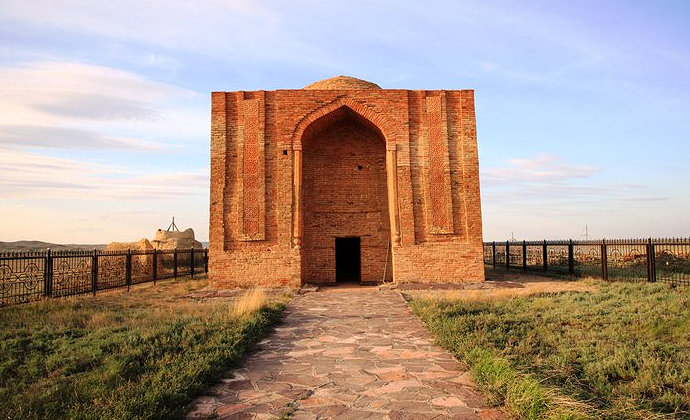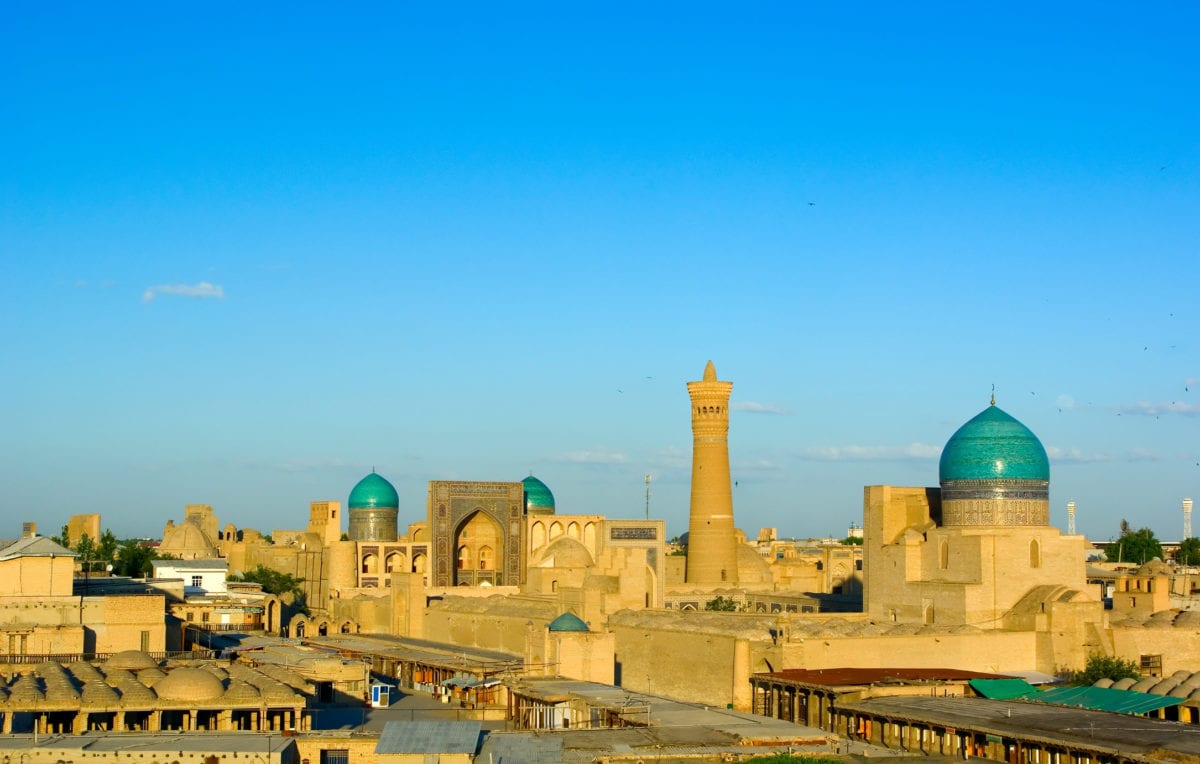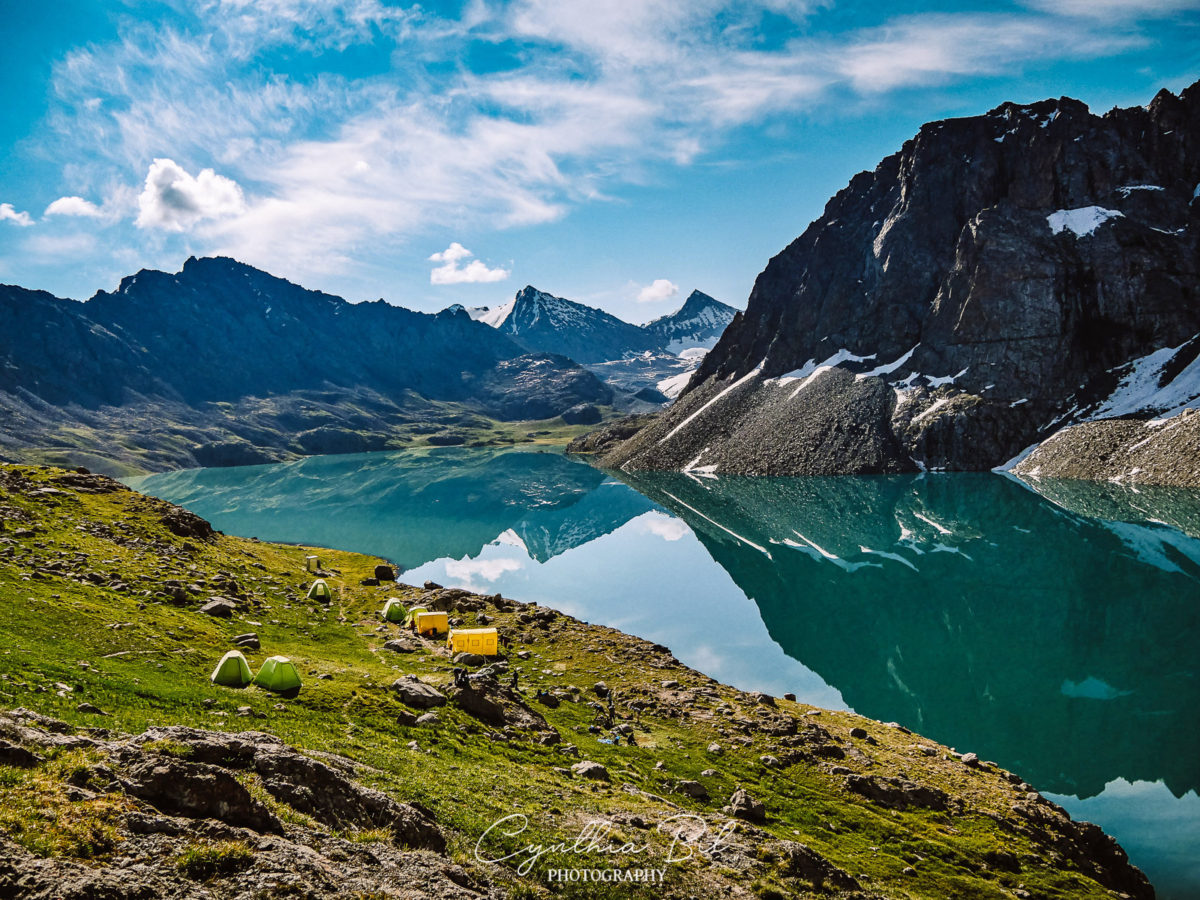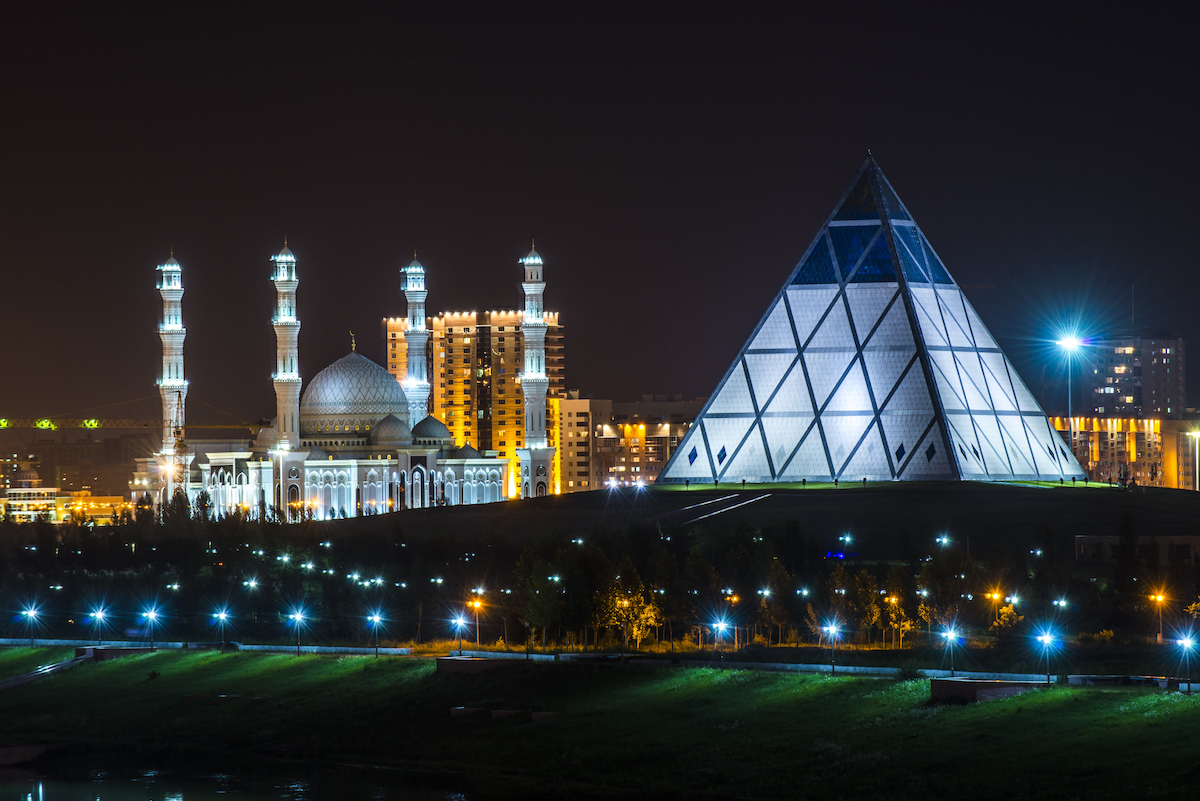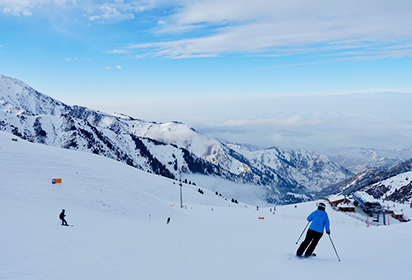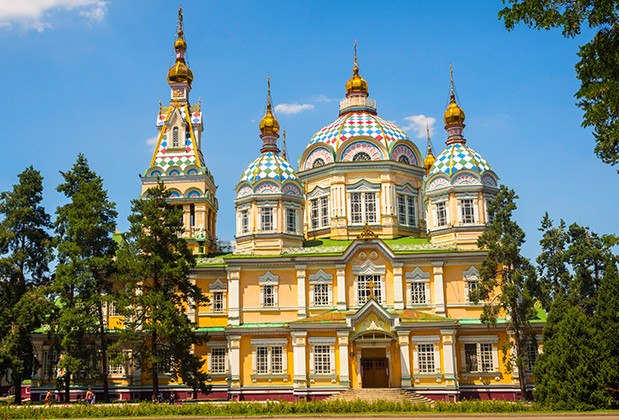A multi-ethnic country that straddles two continents, Kazakhstan is an expression of a Eurasian ideal. But ethnic Kazakhs are also proud of their nomadic heritage.
Paul Brummell, author of Kazakhstan: the Bradt Guide
Why visit Kazakhstan
Stretching from the Tian Shan Mountains in the east across vast steppes to the Caspian Sea in the west, Kazakhstan is a country brimming with travel opportunities. The world’s ninth-largest country is home to some of the most magnificent landscapes on the planet, a dreamland for hikers, skiers and nature lovers alike. And with visa restrictions and red tape being lessened, there has never been a better time to visit.
Kazakhstan is indeed a travel destination if mountains are what you are after. The Kazakh stretch of the Tian Shan Mountains bordering China, Kyrgyzstan and Uzbekistan are heavenly (as the meaning of the name suggests) and tucked away amid the slopes are numerous mountain lakes, including the breath-taking Kolsai Lakes. In the north, bordering Russia, Mongolia and China, the Altai Mountains are ideal for hiking and camping amid the green lush forests and pristine mountain rivers.
But there is more to Kazakhstan than just nature. Almaty, the largest and most charming city in the country, is the national cultural hub and the starting point of a ski holiday. There’s also the Baikonur Cosmodrome, a Soviet-built spacecraft launch facility that is still the largest in the world, as well as plenty of stunning Silk Road monuments, including the 14th-century Khoja Ahmed Yassaui Mausoleum in Turkestan, the most beautiful building in the country.
For more information, check ot our guide to Kazakhstan
Food and drink in Kazakhstan
Food
Kazakh cuisine is heavily based on the nomadic past of the Kazakh people. It is dominated by meat (especially mutton and horse) and various milk products, many of which have no direct English translation. The techniques of preparation emerged out of the importance of ensuring food preservation: thus, there are many dishes based around smoked meat and soured milk. Meat is an important part of the Kazakh diet, and there are numerous jokes about the legendary capacity of Kazakhs for consuming huge quantities of the stuff (the punch lines tend to be of a ‘right, where’s the main course?’ nature). An invitation to a Kazakh feast provides a great opportunity to try many of the classic dishes of Kazakh cuisine together with the rituals that accompany their apportionment, though most dishes are also available in Kazakh or generic central Asian restaurants.
A Kazakh feast tends to be referred to as a dastarkhan, actually the name of the low table around which Kazakhs traditionally sat, on the floor or propped up against cushions, to eat their meals. In rural areas, this form of dining is still common; in larger towns, chairs and tables have taken over, at least among wealthier Kazakh families. On arrival, you will find the table already laden with things to eat, typically fruits, nuts and a range of salad dishes. Tea is served into handle-less cups called pialas, and will be constantly refilled throughout the meal, even as vodka toasts are called for, and other drinks, such as kumiss, a drink of fermented mare’s milk, are also passed round. Appetisers are brought out, focused heavily on sliced meats. Pride of place here goes to various sliced sausages made from horsemeat of varying degrees of fattiness: among the most important varieties are kazy, karta and shuzhuk. Th ere may also be a range of pastries on offer, such as a meat-filled variety, samsa, found throughout the region. Kurt, little balls of dried curd, is a salty snack which has the effect of draining all moisture from your mouth. At some point during the meal a dish of kuirdak will be served. This is made from the internal organs of a sheep or other freshly slaughtered animal: these are cut into small pieces, together with lumps of fat from the animal, cooked in oil, and served with onion and pepper.
Beshbarmak is a traditional nomad dish of finely chopped boiled meat © Nykonchuk Oleksii, Shutterstock
The focus of the meal, and the signature dish of Kazakh cuisine, is beshbarmak. The name means, literally, ‘five fingers’, a reference to the traditional way of eating the stuff and not, fortunately, to its ingredients. It is generally served in a large dish, placed in the centre of the table. It involves large lumps of horsemeat or mutton, boiled on the bone, which are scattered across a bed of flat layers of pasta that have been boiled up in broth. Onion cut into rings, garlic and a scattering of parsley and fennel, completes the dish. The broth, sorpa, is served up separately, in pialas.
Before the beshbarmak is doled out, one tradition that is often incorporated into such a feast, particularly if there is a distinguished guest to be honoured, is the presentation to that guest of a boiled sheep’s head, or koy bas. Since a foreign visitor may well count as the ‘distinguished guest’, be aware that this could be coming your way. The ritual here is that the guest is given a knife, and cuts off pieces from the head, apportioning them to the others around the table. This is traditionally done by identifying pieces appropriate to individual recipients: thus young people often receive a piece of ear, so they may listen well to their elders. You needn’t worry too much about getting this symbolism right; if you can cut small pieces of meat from the head and apportion them, starting with the eldest person around the table and continuing in approximate age order, you will be considered to have discharged your distinguished guest function well. The lumps of meat on the beshbarmak itself are also distributed on the basis of various traditional customs. Thus, elderly or honoured guests tend to be given meat from around the hip, while it is never done to offer brains to children, for fear that they may become weak-willed, or a knee bone to an unmarried woman, lest she be left on the shelf (given the elbow?). Ak nan, a type of bread flavoured with onion, is often eaten with beshbarmak.
Sweet dishes served after the beshbarmak (though they may have been sitting on the table throughout the meal) include irimshik, which is not actually itself particularly sweet: it’s a dry yellowish/orange dish, made of soured cow’s or sheep’s milk that has been boiled and dried. It is, however, an ingredient of the classic Kazakh sweet, zhent, which also contains millet, sugar, raisins and butter and has a rather powdery consistency. Baursaki, small, spherical, fried doughnuts, have an important place in Kazakhstani culture, and feature in many forms of commemorative and celebratory meals. Fruit will also be served at this time. Do expect the unexpected in a Kazakh feast: the kuirdak is, for example, occasionally served right at the end of the meal, after the sweets.
The multi-ethnic character of Kazakhstan and the centuries of trading and interactions along the Silk Routes mean that the cuisine of modern Kazakhstan incorporates a large number of influences alongside those drawn from the nomadic Kazakhs. You will find here some of the dishes popular throughout the region, such as plov, a rice-based dish served with lumps of meat, and pieces of carrot and onion. In Kazakhstan, it is sometimes made in a sweet form, with the addition of dried raisins and apricots. Manty are also popular. These are dumplings, filled with spiced lamb or beef, sometimes with chopped carrot added, and cooked on a steamer. A range of noodle dishes, in particular lagman, are brought from Uyghur cuisine, while shashlik, skewered lumps of various barbecued meats, cooked over hot coals and served with raw onion, is a south Caucasus speciality popular across the region. Korean-style spicy vegetable salads are also found on many menus. Kazakhstan’s large ethnic Russian community has ensured the presence of numerous classic Russian dishes, including salads such as the chopped vegetable in mayonnaise confection described on menus here as olivye but known in western Europe as Russian salad, the ravioli-like pelmeni, sweet and savoury pancakes, or blini, and soups, such as okroshka, a Russian cold soup based on kvass, a fermented beverage made of rye bread, or the traditional Ukrainian and Russian-favourite borscht. In the regions bordering China, traditional Chinese dishes such as noodles and stir fries are also common.
Fuelled by the increasing wealth and aspirations of many Kazakhstanis, a whole range of newer arrivals from around the globe has supplemented these longer-established dishes. Thus, as the Where to eat and drink sections under individual towns make clear, it is possible in the larger cities to find Italian, Mexican, French or Japanese restaurants. Note that in Kazakhstani restaurants side dishes such as vegetables do not usually come automatically with your main dish, and have to be ordered separately. A 10% service charge is typically added. In some top-range restaurants and bars this may be set at 15%. Tipping beyond this is not expected. Many restaurants in Kazakhstan offer a business lunch: this will usually be a set meal or a buffet. These tend to be good value, and are usually served promptly, though they are often fairly unexciting. Restaurants are usually open every day, typically from noon until the last diner has finished up in the evening, though some close for an hour or two mid afternoon. Stolovayas, or canteens, often stay open 24 hours and offer a buffet with a good choice of local dishes for a budget traveller.
Drink
The drink most closely associated with the traditional Kazakh diet is kumiss, prepared from fermented mare’s milk, and believed by Kazakhs to have numerous health-giving properties, from the stabilisation of the nervous system to the treatment of tuberculosis. In parts of the south and west of the country, including Kyzylorda and Mangistau regions, it is supplanted by shubat, prepared from fermented camel’s milk, whose advocates ascribe it an equally impressive range of curative properties, recommending it for the treatment of tuberculosis, diabetes and stomach ulcers. Both kumiss and shubat have a slight fizzy quality and a sour flavour, and are definitely acquired tastes. A foreign delegation greeted on arrival into Kazakhstan by their Kazakh hosts may well be confronted with a girl in traditional dress holding out bowls of kumiss and shubat, accompanied by baursaki. Less frequently encountered, but rather more palatable for most western visitors, is kazhe, which is essentially shubat mixed with grains, which soften the flavour and texture of the drink.
Another important drink for Kazakhs is tea. Green tea is popular, especially in the south of the country, but ‘black’ tea, in other words the standard tea of the English-speaking world, is more prevalent. Ethnic Russians drink this black, sometimes with lemon, but, unusually for the region, Kazakhs traditionally drink their tea with milk. Do not be surprised if your host fills your tea cup only half full: it is an invitation for you to continue speaking. Once your cup is filled, you know it is time to leave. Coffee tends to be hit-and-miss, though there is an increasing range of coffee places offering the cappuccinos and lattes you get back home.
Although some Kazakhstanis refrain from alcohol on religious grounds, the legacy of Tsarist and then Soviet rule has brought with it a tradition of vodka drinking. There are numerous local brands, from expensive varieties such as Snow Queen, which boasts that it has been distilled five times, to cheap and rather unpleasant products. You should avoid the cheapest offerings, particularly from outlets such as kiosks. Kazakhstan also produces a broad range of drinkable if rather sweet brandy, known locally as konyak. There are plenty of Kazakhstani beers: brands to look out for include Beliy Medved, Shymkent and Karaganda. However, in swankier bars and restaurants in Astana and Almaty, local beers and spirits do not always feature on the menu, as they have been elbowed out by imported products. Viticulture has also been gaining momentum. Arba Wine have been producing quality wines since 2010 that have regularly won prizes at international fairs. Menus in swankier restaurants in Almaty and Astana feature Arba Wine.
Health and safety in Kazakhstan
Health
It is recommended that you are up to date with all your primary courses and boosters including diphtheria, tetanus and polio – now given as the all-in-one vaccine (Revaxis) which lasts for ten years. Hepatitis A vaccine will be recommended for longer stay travellers, those living and visiting local people and those undertaking more adventurous travel. The vaccine can be given even close to the time of departure. One dose will protect for at least one year and a booster dose given at least six months later will extend coverage for 25 years. This vaccine may be available on the NHS. Vaccination against typhoid may also be advised for those travelling to more rural areas, particularly where there may be difficulty in ensuring safe food and water supplies.
Additional immunisations to be considered, depending on how long you will be staying in Kazakhstan and your intended activities and lifestyle, include hepatitis B, rabies and tick-borne encephalitis. Hepatitis B is recommended for those working in a medical setting or with children. The vaccine schedule comprises three doses that ideally should be given over a six-month period. If time is short then it can be given at zero, one and two months or for those aged 16 or over; using Engerix B, it can be given over a minimum of 21 days. Both of these more rapid courses need to be boosted after a year.
Rabies is present throughout the country, but is usually easy to avoid unless you are working with animals. A pre-exposure rabies vaccine is advised for those staying longer than a month and for those who are running and cycling as these activities put them at higher risk. It would also be recommended if you plan to be 24 hours or more from reliable sources of treatment. Like hepatitis B, the rabies vaccine comprises three doses and can be given over a minimum of 21 days. Having the pre-exposure vaccine changes what treatment you need and makes it easier to obtain.
Tick-borne encephalitis is a viral infection spread by infected ticks and is more common between April and September. If you intend to go trekking in forested areas during these months, then it would be wise to get immunised. The vaccine is readily available in private travel clinics and consists of two doses of vaccine at least two weeks apart with a third dose given five to 12 months later if at continued risk. Whether or not you have the vaccine, you should take all precautions to protect against tick bites and check and remove any ticks after walking in high-risk areas.
While pharmacies in Kazakhstan, especially in the main cities, are numerous and well equipped, it would be worth packing one or two basic medicines, such as oral rehydration salts. You should ensure too that your travel insurance covers you for medical expenses, including for possible medical evacuation.
Travel clinics and health information
A full list of current travel clinic websites worldwide is available on ISTM. For other journey preparation information, consult NaTHNac (UK) or CDC (US). Information about various medications may be found on NetDoctor. All advice found online should be used in conjunction with expert advice received prior to or during travel.
Safety
Kazakhstan is generally a safe country to travel around. Locals usually travel in groups and with families; single travellers should not be unnecessarily alarmed when asked if they are not afraid to travel in Kazakhstan on their own – this is not a reflection of the country’s safety situation. That said, exercising caution is always the best practice to adopt.
Pickpocketing, especially in crowded places such as markets and on busy public transport, can occur. Ensure that you keep your money and documents somewhere secure. If you are driving, don’t leave valuables visible in your parked vehicle: there have been reports of ‘smash and grab’ thefts.
While the informal taxi system in operation throughout the region provides a quick and cost-effective means of getting around town, it does carry with it certain risks, and you should be alert to these if you decide to hail a car, particularly at night. If a car stops for you that you do not particularly like the look of (because it appears to be in poor condition, or the driver seems drunk, or there are two or more men in it), simply wave it away again. The locals do this all the time. There have been serious incidents of violent robbery involving foreigners leaving bars and clubs late in the evening, sometimes somewhat incapacitated by drink, who have taken informal ‘taxis’ waiting outside the premises. If you are leaving a club or bar late, it is much safer to get the establishment to call an official taxi for you.
The taxi drivers waiting for arriving passengers at Almaty airport are a particularly frequent source of complaints. Often this is simply a matter of overcharging, but there have been more sinister incidents, including drivers taking arriving visitors into the middle of nowhere, and demanding money to return them to the centre of the city. If you need to take a taxi from the airport into the city, book an official one at the desk just before you leave the arrivals hall. There have also been reports of people posing at the airport as ‘meet and greet’ representatives, sent by the passenger’s inviting organisation to collect them. In some cases, they seem to have been able to get hold of passengers’ names, adding to the credibility of the story. They then drive you off somewhere remote and extort money to take you to your destination (similar to the taxi driver scam mentioned above). If you are being met at the airport, clearly establish the arrangements in advance with your inviting organisation, including how the person meeting you will be identified.
Although levels of violent crime in Kazakhstan are relatively low, muggings, especially at night, are a concern. The oil boom towns in the west of the country, especially Atyrau, are particularly problematic in this respect. You should avoid walking alone at night, and keep to well-illuminated areas.
The spiking of drinks has been reported in clubs and bars in Almaty, where the motive is generally robbery rather than sex, and the targets more often men than women. Keep a close eye on your drink. The effects of alcohol are at the root of many reported violent incidents in Kazakhstan. If a fight breaks out in the bar you are in, pay up quickly and leave.
Cases of extortion of money by police and other law enforcement officers are less common in Kazakhstan than they used to be (though petty corruption on the part of the traffic police remains a considerable problem). Police in Kazakhstan are allowed, perfectly legitimately, to request to see identification documents, and you should co-operate with this. There have, however, been concerns about extortion by people impersonating law enforcement officers: if you have any doubts about the bona fides of the person who has stopped you, you are entitled to ask to see their credentials before producing your passport. If you doubt the legitimacy of the ‘officer’, or are being asked for a bribe, try to take down their name and badge number, as well as the registration number of any vehicle. Do not get into the back of a police car or go anywhere else that you cannot be seen by passers-by. If in doubt, ask to accompany the officer to the closest police station to resolve any matters (invented or otherwise) there.
Female travellers
The usual personal safety precautions should be exercised for women travellers. You should dress modestly, especially in conservative southern and western Kazakhstan and in rural areas (although this is not a practice always followed by the locals). Particular caution should be taken when hailing taxis; phoning for a cab, or getting the establishment you are in to do this for you, is a safer option. Unaccompanied women may receive unwanted attention in bars and clubs but this is usually deflected with a few terse words. If the harassment continues, alert the management or leave the premises and find a more pleasant alternative. Try to avoid physical confrontation as alcohol-fuelled violence is not uncommon.
LGBTQ+ travellers
Homosexuality has been legal in Kazakhstan since 1997, but while a small gay scene has developed in Almaty, same-sex relationships are still often seen to be symptomatic of illness. Visitors are advised against showing open signs of affection in public, especially away from the larger cities.
Travellers with disabilities
Disabled visitors may experience difficulty travelling in Kazakhstan. Public transport is rarely able to carry wheelchairs, few buildings have disabled access, and streets are littered with trip hazards such as broken paving, uncovered manholes and utility pipes. Hotel rooms are often spread over multiple floors without lifts, and assistance from staff is not guaranteed. If you have a disability and are travelling to Kazakhstan, you would be advised to travel with a companion who can help you when the country’s infrastructure and customer service fall short.
Travelling with children
Travel with children is relatively easy given Kazakhstanis’ focus on family life. Children are welcomed in restaurants and shops but you may have difficulty manoeuvring pushchairs in and out of buildings and along broken pavements. Nappies, baby food and other similar items are widely available in supermarkets, but you are unlikely to find European brands outside of major cities. Journeys by car and public transport are often long and uncomfortable, which may deter families with younger children from travelling into the interior of the country.
Travel and visas in Kazakhstan
Visas
Since July 2012 visitors from the European Union (except Bulgaria and Romania), North America and Australasia no longer need a visa to visit Kyrgyzstan for a period of up to 60 days. The same waiver also applies to citizens of Bosnia and Herzegovina, Monaco, Iceland, Liechtenstein, Norway, Switzerland, Turkey, Cuba, Japan, South Korea, Singapore, Malaysia, Mongolia, Brunei, most Gulf Arab states – Bahrain, Kuwait, Qatar, UAE, Saudi Arabia – Russia and former countries of the Soviet Union. If planning to stay longer than 60 days a visa will be required, which should be obtained either in advance at a Kyrgyz embassy or on arrival at Manas airport.
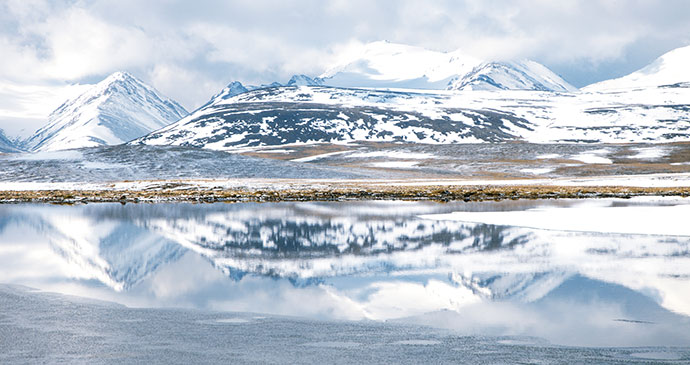
Since 2012, most visitors from the EU no longer need a visa to visit Kyrgyzstan © Elena Moiseeva, Shutterstoc
For those passport-holders of countries that do require a visa – mostly African, Middle Eastern, South Asian countries, China and some South American countries – these can be obtained in advance at a Kyrgyzstan embassy. Most will be required to obtain a visa support letter from the Consular Department of the Ministry of Foreign Affairs if travelling for business purposes or, if travelling privately or for the purposes of tourism, an invitation letter (usually referred to as LOI – ‘letter of invitation’) issued by the Ministry of Internal Affairs. This additional paperwork can be issued, at a price and with some advance notice, by contacting one of the Bishkek travel agents listed. Visas are normally issued for 30 days.
Citizens of a small number of countries that require visas are able to obtain them without providing visa support or a LOI, and can obtain visas on arrival by air for between US$50–100 depending on length of stay and whether single or double entry. The countries not requiring visa support are: Albania, Andorra, Argentina, Brazil, Bulgaria, Chile, Cyprus, Indonesia, Israel, Macedonia, Mexico, Montenegro, Oman, Philippines, Romania, San Marino, Serbia, South Africa, Thailand, Venezuela and Vietnam.
Getting there and away
By air
Kyrgyzstan’s main international airport is Manas Airport in Bishkek (airport code: FRU; Tel: 693 109; Email: [email protected]) although a few flights from Russia also go direct to Osh. Manas Airport lies about 25km north of the capital, a 40-minute drive away.
From the UK
There are no longer any direct flights between the UK and Bishkek. British Airways used to fly three or four times a week to Almaty, a four-hour drive from Bishkek in neighbouring Kazakhstan, but this service was suspended in 2015.
The best way to reach Kyrgyzstan by air from the UK or elsewhere in Europe is to fly to Moscow or Istanbul and then transfer to a direct Bishkek flight. Flying via Moscow, there are flights with Aeroflot that change planes at Sheremetyevo airport. These start at about £400 return and fly daily but there is sometimes a long wait at the transit airport. A little more expensive, but more comfortable and reliable, are the daily flights with Turkish Airlines via Istanbul’s Ataturk airport, which start around £420 return. Another, usually less expensive Turkish alternative is with the budget carrier Pegasus Airlines that flies daily to Bishkek from London Stansted via Istanbul’s Sabiha Gökçen Airport. These flights can cost as little as £330 return and represent a real bargain, even if you do have to buy all your own drinks and meals on board. Because of seasonal demand flights tend to be more expensive during the peak months of July and August and so it is wise to book as far ahead as possible. Flying Air Astana, with a transfer in Astana, Kazakhstan, is another option from London.
From Europe
Other than BMI flights from London, the only other direct flights from Europe are with Turkish Airlines, which fly daily from Istanbul, and regular flights from Moscow with Aeroflot and other carriers. Flights to Bishkek from western European countries tend to connect with either Aeroflot in Moscow or Turkish Airlines in Istanbul. In Germany, Lufthansa do not fly to Bishkek but do regularly fly to Almaty in Kazakhstan.
From Russia and CIS countries
Kyrgyzstan has regular direct flights from Moscow with Aeroflot, Ural Airlines, Air Manas and Avia, as well as three times a week from St Petersburg, twice a week from Krasnoyarsk, three times a week from Yekaterinburg, and weekly from Novosibirsk and Omsk in Siberia. There are flights four times a week from Dushanbe in Tajikistan, with both Avia and Tajik Air, as well as regular flights to Tashkent in Uzbekistan and Almaty in Kazakhstan. Air Manas has regular flights to Tashkent, while Air Astana also flies to Bishkek from Almaty and Astana.
From elsewhere, China Southern Airlines flies to Bishkek several times a week from Ürümqi in Xinjiang. There are also flights from Ulaanbaatar in Mongolia with Turkish Airlines and Dubai with the budget carrier Fly Dubai. Air Manas also has regular flights from New Delhi and Kashgar.
From the USA and Canada
There are no direct flights. Flights from North America can either link with the direct BMI service from London to Bishkek or alternatively go via Moscow (Aeroflot) or Istanbul (Turkish Airlines).
From Australia and New Zealand
Probably the easiest way to reach Kyrgyzstan from Australasia or Southeast Asia is to fly to Tashkent via Bangkok and then either take a connecting flight or, politics permitting, travel overland to Kyrgyzstan.
By train
The great adventure of arriving in Bishkek by rail may not quite be as romantic as its sounds. It is a very long journey and there is an awful lot of dull Kazakh steppe to stare at before Kyrgyzstan is reached. In addition, some of the passengers travelling in platskart (third class) are smugglers, and some consider that it is not a safe journey for foreigners to take, at least in the lowest class.
In theory, at least, it is possible to reach Bishkek by train from anywhere in Europe by way of Moscow and the service from there. Naturally, having to travel through both Russia and Kazakhstan en route, there are going to be visa issues to consider. Train number 18, the Kyrgizia, leaves Moscow’s Kazan station twice a week on Thursday and Saturday at 22.40, to arrive just over 72 hours later in the late evening of the fourth day. This currently costs about 14,000 roubles (£170) in platskart (third class open carriage) and about 20,000 roubles (£240) in kupe (four-berth sleeper) if tickets are bought at the station. Booked through an agency they will cost considerably more. Trains number 17 and 27 to Moscow from Bishkek leave on Monday and Wednesday at 09.17 and take just over 73 hours to reach Moscow.
Rather than going all the way to Bishkek it is possible to leave any of the trains at Taraz (Dzhambul) in Kazakhstan and then enter Kyrgyzstan’s northwest Talas Province by minibus, saving five hours on the overall train journey.
Another alternative is to travel by train from Moscow to Almaty, although the direct service was discontinued in 2017 and the journey now requires a change in Saratov. In the summer season trains run once a week on Thurs evenings between Tashkent and Bishkek continuing to Balkychy but they are very slow (19+ hours to Bishkek, 24+ hours to Balykchy) and take a meandering route through Kazakhstan.
By road
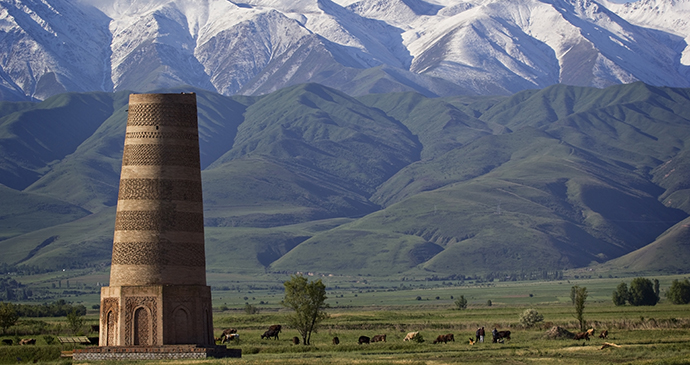
From Kazakhstan
There are frequent services between Almaty and Bishkek by share taxi (2,500 Kazakh tenge) and marshrutka (1,500 Kazakh tenge) taking about five hours. The border is open 24 hours a day. From Taraz (Dzhambul) there are regular minibuses that connect with Talas in Kyrgyzstan’s northwest. Having been closed for three years between 2010 and 2013, the Karkara Valley route between Kegen (Kazakhstan) and Ken-Suu/Tyup (Kyrgyzstan) is now open again between mid-May and mid-October, although the exact dates tend to vary. Public transport on the Kazakh side goes as far as Kegen (around $10 per person in a share taxi from Almaty) from where taxis to the border can be caught (around $10). On the Kyrgyzstan side, it is usually possible to find a ride 20km to the village of Sary-Tologoy for around 1,500som. A daily minibus runs between Sary-Tologoy and Karakol (80som).
From Uzbekistan
The northern route between Tashkent and Bishkek passes through Taraz in Kazakhstan, where there is usually a change of transport. A Kazakh transit visa is needed for some nationalities on this route. To reach Bishkek from Tashkent it may well be quicker and cheaper, if the border is open, to go first to Osh via the Fergana Valley and then fly to Bishkek from there.
From Dostlyk, near Andijan in Uzbekistan’s Fergana Valley, there are normally plenty of share taxis running to the Kyrgyz border close to Osh, from where a minibus (10som) may be taken into the city. Dostlyk may be reached either from Andijan or Tashkent by share taxi. This border is open 24 hours a day. There is another border crossing at Uch-Kurgan on the road between Karakol (not the Lake Issyk-Kul town) and Namangan but this tends to close periodically. No public transport passes through here anyway, so it is necessary to take a taxi both sides. There is also another Fergana Valley crossing from Uzbekistan at Khanabad, just to the south of Jalal-Abad, but this also closes periodically. Although there are further crossing points between the two countries in the Fergana Valley, most of these will not allow foreign travellers through as they may be designated for locals only.
From Tajikistan
There is no regular transport along the Pamir Highway between Murgab and Osh, although private 4×4 vehicles may be hired for this route in either direction. Travelling this route requires a Gorno-Badakhshan Autonomous Oblast (GBAO) permit in addition to a Tajik visa. There are share taxis between Isfara in the Tajik section of the Fergana Valley and Batken in southwest Kyrgyzstan; also between Khojand and Isfana in far south-western Kyrgyzstan. The Kyrgyz-Tajik border between Garm and Daroot-Korgon has been closed for foreign nationals for several years but it may become open at some stage in the future.
From China
There are two overland routes to and from China. The Torugart Pass in the southern Naryn province is technically closed to foreigners but permission to cross is granted if travellers have pre-arranged transport meeting them on the other side of the border and have documentation to prove this. The public bus that plies this route between Kashgar and Naryn cannot be used by foreign nationals. Further south, the Irkeshtam border, to the east of Sary-Tash in Osh province, permits crossing in either direction without any special conditions or documentation. A public bus normally runs between Kashgar in China’s Xinjiang province and Osh twice a week in both directions and takes at least 18 hours overnight. It is available for all to use.
Getting around
Getting around Kyrgyzstan is reasonably straightforward between the major centres – Bishkek, Karakol, Naryn, Jalal-Abad and Osh. Public transport tends to be a little erratic at times and some of the roads are in poor condition although they have noticeably improved in recent years. Hiring a taxi for a couple or small group for long distances is a relatively cheap and fast way of getting about. Self-drive car hire is also slowly becoming more popular. Given Kyrgyzstan’s pot-holed roads, its eccentric driving habits and a police force keen to extort fines from their motorised victims, car hire is not for everyone but it undoubtedly affords a great deal more flexibility and spontaneity than is ever possible by public transport. Flying may be a viable option for some north–south travel as it is markedly quicker and may be only a little more expensive than travelling by road.
By bus and minibus
Other than for local city services, very few buses operate in Kyrgyzstan these days. Most long-distance bus services have now been superseded by minibuses (marshrutki) running the same routes, which are by and large quicker. Minibuses tend to congregate outside bus stations and leave when full, usually with about 12–18 passengers plus the driver. Some marshrutki that travel relatively short distances along fixed routes, such as those along the shores of Lake Issyk-Kul, operate rather like a local bus service and do not wait to fill up before leaving, as they constantly pick up and drop off all along their route.
By taxi
Kyrgyzstan’s taxis will go almost anywhere if you pay them: a road surface of little more than loose rocks and sheep holds little fear for the average Kyrgyz Lada or Zhiguli driver. Fares are loosely negotiable, but are usually about twice the bus fare multiplied by four, the number of passenger seats. In many instances there is no bus or minibus service and so a taxi is sometimes the only option. If there is a CBT network in the town or village they usually have drivers who are familiar with the funny ways of the tourist and knowledgeable about the sort of places that they wish to go. Taxis may be hired for less than the CBT rate in the bazaar, although this is very dependent on the language and negotiation skills of the client, as well as how desperate the driver is to find a fare.
More popular routes often have shared taxis running the same routes as the minibuses and buses. They are effectively the same as ordinary taxis except they run the same route regularly and aim to fill the car with four passengers who all with less than a full complement of passengers if those present agree to pay for the empty seat(s) between them. Other than flying, shared taxis are the best way to travel between Osh and Jalal-Abad and Bishkek. They tend to cost less heading south than they do returning to Bishkek. Typical shared taxi fares are Bishkek–Osh, 800–1,000som; Osh–Bishkek, 1,200som.
When to visit Kazakhstan
Kazakhstan’s extreme continental climate makes for large seasonal variations, with hot summers and cold winters. Its large size makes for big regional variations too. In general, the northern regions are at least a few degrees colder than the south.
Thus winter in northern Kazakhstan means snow cover between November and April, and temperatures regularly below –20°C. In Kyzylorda and Mangistau regions, there is relatively little snow, and winter temperatures that, while still often below zero, are nothing like as extreme. Winter brings with it opportunities for snow-related sports across Kazakhstan, including downhill skiing at Shymbulak and Ak Bulak outside Almaty. Cities in the north build elaborate ‘villages’ of ice sculptures. On crisp, cold but sunny winter days, Kazakhstan is perhaps at its most beautiful. However, for everyone except winter sports enthusiasts winter is nonetheless deservedly the low season for tourism. The cold weather inevitably restricts movement, and travel schedules are also subject to disruption: for example, flight delays caused by freezing fog or snowstorms. If you do come to Kazakhstan in winter, you will need to prepare your wardrobe carefully for the cold.
The Nauryz festival on 22 March announces the arrival of spring, with festive yurts placed in the squares of the main cities. It can, however, still be cold in the north at this time. Late April and May bring a wonderful carpeting of wild flowers to the steppes, and to the slopes of the mountains. The tulips on the slopes of the Tian Shan in May are a particularly fine sight. The trekking season in Kazakhstan starts to develop around mid-May, running to late September, though some high-altitude routes remain closed until June or July. The summer months are in general an excellent time to come to Kazakhstan, and represent the peak of the tourist season. With temperatures in the southern regions frequently reaching well above 30°C in July and August, budget travellers planning to visit at this time should consider trading up to accommodation with air conditioning. It is also worth bearing in mind that the best-known spots can get pretty packed with domestic tourists in August. If you are heading to a resort area at the height of summer where the attractions include water to swim in, it is a particularly good idea to pre-book your accommodation.
Autumn too can be a good time to visit, especially the south, where in the low-lying areas the weather often remains pleasantly warm, albeit with increasingly chilly evenings, into November. Note that Almaty hosts the Kazakhstan International Oil and Gas Exhibition in the first week of October: at this time many mid- and top-range hotels raise their prices, and getting a room at any price can prove difficult.
Specialist wildlife and fishing holidays all have their own seasons. For example, as regards fishing, the season for catfishing in the Ile Delta is May–June and September–October. Trout fishing in the Tian Shan is at its best between September and mid-November.
Climate
In the east and southeast of the country are high mountain ranges: the Tian Shan along the borders of Kyrgyzstan and China, and the Dzhungarsky Alatau and Altai ranges further north along the Chinese border. Kazakhstan’s highest peak, Khan Tengri in the country’s southeastern corner, shades 7,000m. In contrast, in the west, close to the Caspian, lie some of the lowest points on the territory of the former Soviet Union. Kazakhstan’s lowest land altitude is the Karagiye Depression in Mangistau Region, at –132m. Many of Kazakhstan’s rivers flow northwards and westwards from its high ranges, and their continuations in China and central Asia: the Irtysh, with its tributaries including the Ishim and Tobol, flows north into Russia, to join the Ob and thence to the Arctic Ocean. The Syr Darya feeds the Aral Sea; the Ile runs into Lake Balkhash. Many rivers simply expire in the arid expanses that straddle much of the country. In the west of the country the Ural and Emba rivers flow south, rising in the Ural Mountains in Russia, and disgorging into the Caspian. Kazakhstan also boasts some 48,000 lakes.
Belts of pine and birch forest in the north give way to the world’s largest dry steppe region, a vast expanse of open grassland covering more than 800,000km2. With gradually declining rainfall and increasing temperatures from north to south, the steppe belt gives way to semi-desert and then to desert.
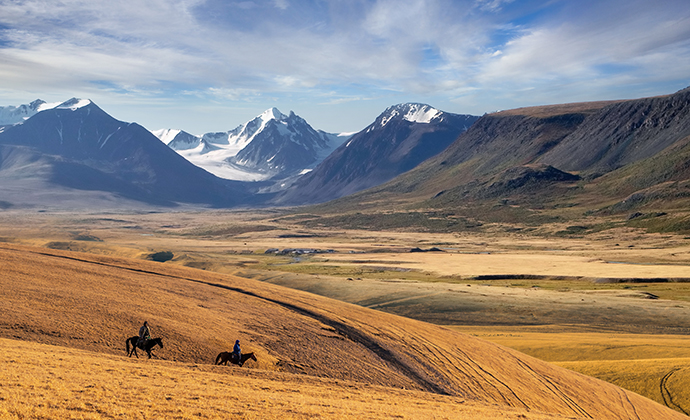
The steppe is characterised by a semi-arid climate © Aureliy, Shutterstock
Far from the moderating influences of the oceans, Kazakhstan has an extreme continental climate. Average January temperatures range between –19°C and –4°C; average July temperatures between 19°C and 26°C. Extremes can reach –40°C and 40°C, respectively. There is a considerable variation between north and south, with summers warmer and winters milder in southwestern parts of Kazakhstan. Rainfall is low across most of the country, from around 400mm in the north to 150mm in the south, meaning that irrigation is usually required to support crop growth. Rainfall levels are higher in the Tian Shan and Altai mountains, reaching 1,500mm in some parts of the latter. High winds are a notable feature of Kazakhstan’s wide expanses of steppe and semi-desert.
What to see and do in Kazakhstan
Aksu Zhabagly Nature Reserve
Established in 1926, the Aksu Zhabagly Nature Reserve is the oldest in central Asia. It protects part of the Talasky Alatau range of the western Tian Shan Mountains. The territory of the reserve ranges in height from 1,100m to Peak Sayram at more than 4,200m, the latter resting at the boundary between the Aksu Zhabagly Nature Reserve and Sayram-Ugam National Park. Peak Sayram is a popular place for mountain climbers; Russian singer-songwriter Vladimir Vysotsky is among those who have made it to the summit. The reserve offers a range of environments from steppe to upland meadows, juniper forest and snow-capped mountaintops fringed by large glaciers.
The reserve gets its name from the two main rivers flowing through its territory. The Aksu River means ‘white water’, the colour derived from its passage through the limestone mountains. The Zhabagly River is named from the Kazakh word meaning ‘one-year-old horse’. A legend surrounding this name tells of how the first settler of this picturesque valley, arriving here with his family, was forced to leave to join his tribesfolk in a war. In his absence, the family members he had left in the valley were kidnapped by bandits, his livestock slaughtered and his yurt razed to the ground. When our hero returned from the war he found only scorched ground where his yurt had stood. In total despair, the horse he had left as a foal suddenly ran towards him, having miraculously survived both the bandits and the subsequent winter. Our hero saw the horse’s appearance as a sign that he should not give up, and persevered with the establishment of a settlement on the banks of the river he named in his horse’s honour. And the horse tasted good, too. (OK, I revised the ending slightly.)
Wildlife found in Aksu Zhabagly Nature Reserve includes the Eurasian lynx © Stanislav Duben, Shutterstock
The reserve is home to many rare species of plants and animals. In late April and early May, the focus of all those who come to the reserve is the bright-red Greig’s tulip: one sight, known as Red Hill because of the colour the tulips turn it in spring, boasts densities in places of more than 60 wild tulips per square metre. Kaufmann’s tulip is another important species of the western Tian Shan, often found at rather higher elevations. The local tourism authorities bill these mountains as the possible birthplace of the wild tulip. Among the mammal species found in the reserve, the snow leopard is one that visiting tourists are unlikely to encounter. Numbers in the reserve are low; it is confined to remote spots and hunts mainly at night. The reserve also provides a home to the white-clawed Tian Shan bear, a relative of the brown bear, the Siberian ibex and Eurasian lynx. The Menzbier’s marmot, smallest of all the marmots, is endemic to the western Tian Shan. It has dark, almost black, fur on the upper parts of its body; pale yellow underneath. One further mammal rumoured by some locals to live in the remote mountains of the reserve is a yeti, a wild snowman. An expedition in the Soviet period even tried to find him.
The largest of the birds found in the reserve is the lammergeyer. You may also see the golden eagle, often found circling above the Aksu Canyon, the Himalayan griffon vulture and the Eurasian eagle owl. Another rare species found here is the blue whistling thrush: hearing its whistle is considered good luck.
Almaty
Almaty may have lost its status as the capital city of Kazakhstan in 1997, but it remains the largest and most cosmopolitan city in the country, and Kazakhstan’s financial, cultural and educational hub. Most international flights arrive in Almaty; it has the widest range of hotels, restaurants and bars you will find in Kazakhstan. You will hear more Russian spoken here than Kazakh, although ethnic Kazakhs make up 51% of the population: Almaty is one of the places in which the broad ethnic diversity of Kazakhstan is most apparent, with expatriates working for the many foreign firms headquartered here adding to the mix.
Almaty’s modern cityscape is set against a striking mountain backdrop © EXPO-2017 National Company
There is no attractive ‘old city’: an earthquake in 1887 left just one brick building standing. But there are some interesting museums, attractive parks and intriguing buildings chronicling Almaty’s Tsarist, Soviet and post-independence history. A stunning location adds much to Almaty’s allure. The city sits at the northern foot of the Zailysky Alatau range, the northernmost line of the mighty Tian Shan Mountains. The peaks, rising above 4,000m and snow-capped for much of the year, offer a beautiful southern backdrop to the city, though the smog that sometimes hangs over the urban area all too frequently has the effect of spiriting the mountains away. The Zailysky Alatau are easily accessible: the starting points for some excellent trekking routes amid Tian Shan firs and up to mountain passes and glaciers are just a few minutes’ drive from the centre of town.
The city itself is built on a slope, with the highest ground to the south, at the foot of the mountains. Across this slope meander several streams – the Bolshaya Almatinka, Malaya Almatinka and Esentai – each fed by snow melt from the mountains. The water from these streams fuels an irrigation system dating from the 19th century, with channels known as aryks running alongside the grid-patterned city streets. These provided the water to support lines of poplar trees, which give Almaty, fondly referred to as the Garden City, a verdant appearance. According to a local legend, in the late 19th century, young men were allowed to get married only after having planted 15 trees. The streams also feed the city’s 125 fountains and since 2007, Almaty has been celebrating 25 May as the Day of Fountains. This is altogether a city that can beguile, whose easy-going charms lure visitors to stay longer than planned.
Altai Mountains
The Altai Mountains straddle four countries: Russia, Kazakhstan, Mongolia and China. The segment falling within Kazakhstan, in the far northeast of the country, gives the country some of its most delightful landscapes. Deciduous forests at low altitude, with birch and aspen, rise to mountain taiga, with cedar, pine, silver fir, larch and birch all prominent. Above around 1,800m the forest gives way to mountain meadows, and then to tundra. The highest point, the twin-headed peak of Mount Belukha on the border between Russia and Kazakhstan, reaches 4,506m. Images taken from the space show the mountain as flower-shaped amid the surrounding peaks. The forests, which experience high rainfall, are rich in mushrooms and berries. Mammals found here include bear, maral deer, red wolf, elk and sable. There are many charming villages in the area, of log-walled cottages with corrugated metal roofs. Logs for winter heating are piled high outside.
There is a strong spiritual dimension to the Altai Mountains. Old Believers, who separated from the hierarchy of the Russian Orthodox Church in the mid 17th century in protest at the reforms of Patriarch Nikon, found refuge in the remote valleys of the Altai. The graves in local Muslim cemeteries are distinctive: with fiveor six-sided wooden pyramidal frames, a little picket fence around the base of the pyramid and a crescent moon at the apex. The size and striking form of Mount Belukha, whose peaks are often shrouded in cloud, have attracted many faiths. Shamans consider the mountain to hold particular significance: its double-headed peak suggests a certain femininity of form that made the mountain for them the female counterpart to Khan Tengri, the home of the male god of the heavens. The spiritual teacher Nicholas Roerich, who spent time in the area with his family during his four-year Asian Expedition in the 1920s, was gripped by the place. Perhaps here might be found the legendary Buddhist kingdom of Shambala, always believed to have been hidden somewhere in central Asia, beyond the peaks of the Himalayas. Followers of Roerich’s Agni Yoga make pilgrimages to Mount Belukha.
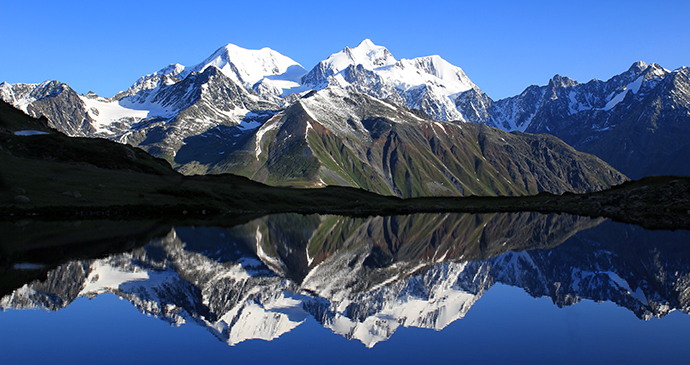
The pop group Three Dog Night once sang about the virtues of the rain of Shambala in washing away troubles and pain, and certainly the Altai Mountains in Kazakhstan receive plenty of rain. One positive result of this is the abundance of mushrooms and berries to be found in the forests. After rains the locals take to the woods with plastic buckets. Another object of local harvest is the antlers of young maral deer. The antlers are a source of pantocrine, believed by adherents to enhance strength and sexual potency, and by some even to ward off the ageing process. The industry, which originated in the area in the 18th century with the Old Believers, involves organised stag farms. The antlers are removed from the young deer and boiled, forming a pantocrine-enriched broth. Several stag farms and sanatoria in the area offer visitors the opportunity of a rejuvenating bath in pantocrinerich waters. If bathing in antler-infused water is your bag, some Oskemen travel agencies can help set this up. The season for pantocrine treatments is a short one running roughly from the beginning of June to mid-July.
Altyn Emel National Park
Established in its present form in 1996, and covering an area of some 460,000ha, the Altyn Emel National Park is one of the largest in Kazakhstan. Its southern boundary is formed by the Ile River and by Lake Kapchagai. The northern boundary of the park is marked by a line of hills, a western spur of the Dzhungar Alatau range, whose name changes from west to east: Degeres, then Altyn Emel, then Koyandytau. It is said that the name ‘Altyn Emel’, which means ‘golden saddle’, was given to the hills by Genghis Khan when he passed this way in 1219 and saw them covered with sun-yellowed grass. In the east of the park are two further ranges, Katutau and Aktau. The rest of the park comprises dry plain.
Scientists are still divided over exactly how the Singing Sand Dune produces its humming sound © Sergey Terekhov
This is one of the best places in Kazakhstan to see herds of wild hoofed mammals. The park boasts a population of some 6,000 goitered gazelle, known as jieran. In the 1970s, a small population of central Asian wild ass, or kulan, was brought here from the Barsakelmes Nature Reserve, in response to the ecological problems associated with the desiccation of the Aral Sea, which turned Barsakelmes from an island into a peninsula and greatly raised the salinity of the Aral. The wild ass have thrived in Altyn Emel, and now have a population of some 2,000. Much harder to spot are the park’s arkhar, some 400 in number, which prefer remote upland environments. The park authorities’ latest projects are the introduction to Altyn Emel of the Przhevalsky horse, using horses brought from Munich Zoo, and the Bukhara deer. The mammals are at their most active, and easiest to spot, early in the morning and late in the afternoon.
The Altyn Emel National Park also boasts some striking archaeological and natural sights, of which the two most important are the Iron Age burial mounds of Besshatyr, and the large barchan, or more accurately barchans, known as the Singing Sand Dune.
While some national parks in Kazakhstan have taken a cautious approach to tourism, seeing their role as to protect the natural environments from people rather than to attract visitors in, Altyn Emel sees tourism development as one of its central activities. In terms of tourist routes, the park is effectively divided into two separate parts (approximately 260km2) by a specially protected reserve, or zapovednik, in the central section, through which tourists are not usually allowed to pass. The small rural village Basshi, housing the park headquarters and accommodation, is the gateway to the sights of the eastern section of the park, including the Singing Sand Dune, and Aktau and Katutau hills. It is also here that all visitors overnight. The western section of the park, containing the Besshatyr burial mounds and Terekty petroglyphs, is best approached direct from Almaty, and you will need to make your payment in advance through the park’s Almaty office or a travel agent.
Astana
Astana is an urban expression of Kazakhstan’s post-independence achievements, a statement of an increasingly wealthy and confident country. The city is rich with the symbols of the post-independence regime: a tower based around the imagery of the Kazakh ‘tree of life’, a pyramid to celebrate peace and inter-religious harmony and, in a nod to the nomadic history of the Kazakhs combined with a modern consumerism, a giant transparent tent which shelters a shopping and entertainment complex from the extremes of this steppe climate. The politicians and officials working in the city, which has been Kazakhstan’s capital only since 1997, are housed in apartment complexes of increasing architectural audacity: shimmering to represent the northern lights, or aping one of the Stalinist-era ‘Seven Sisters’ skyscrapers in Moscow. To get a clear sense of Kazakhstan’s aspirations, you should come here.
Astana is not short of eye-catching architecture © EXPO-2017 National Company
The capital of Kazakhstan since 1997, Astanahas grown at a staggering rate. With a population of little more than 300,000 when it inherited the mantle of national capital from Almaty, it grew to beyond half a million in just a few years. Plans that Astana would top one million people by 2030 have been revised forwards. President Nazarbayev wants Astana not just to grow, but also to be special, a sparkling symbol of independent Kazakhstan. World-renowned architects have been enlisted to help build the city: its general plan designed by Japanese architect Kisho Kurokawa; some of its most eye-catching buildings by Norman Foster. The rise in the cost of borrowing precipitated by the US sub-prime mortgage crisis in 2007 slowed the building boom, but the skyline of Astana remains dominated by cranes as the new capital continues to take shape on the steppe. Its birthday is officially celebrated on 6 July, which also happens to be the birthday of President Nazarbayev. If you are travelling to Kazakhstan around this time, keep your eyes open for events in the city around this date.
Baikonur Cosmodrome
The cosmodrome is located north of Baikonur town, on the other side of the Orenburg–Tashkent railway line and the main east–west road. The checkpoint marking the entrance into the cosmodrome is about 8km north of the town. The facilities are widely scattered across the open steppe; your guided tour will include only a few of the more historically interesting sites. The overall distribution of facilities across the territory of the cosmodrome tended to reflect the work of the competing design bureaux involved in moving the Soviet missile and space programmes forward.
Baikonur Cosmodrome has almost a dozen launch pads, active and inactive © Ninara CC-BY
The central area of the cosmodrome was based around the processing and launch facilities of the designer Sergei Korolev. The western side, or left flank, served the ballistic missiles and space launchers developed by the design bureau of Vladimir Chelomei, including the facilities for the Proton rocket. The eastern side, or right flank, was devoted to facilities supporting Mikhail Yangel’s bureau.
Borovoye
This landscape of lakes, hills, weathered granite outcrops, and pine and birch forests offers some of the most picturesque scenery in northern Kazakhstan, and attracts gushing tourist agency labels such as ‘Kazakhstan’s Switzerland’ and ‘the pearl of Kazakhstan’. Named, since 2000, the Burabay National Nature Park, the western boundary of this landscape is formed by the boomerang-shaped Kokshetau Mountains, which run roughly north to south. The ‘Blue Mountains’ do indeed take on that hue when viewed from afar across the surrounding steppe. Around the foothills of the range lie several lakes, and most of the area’s tourist infrastructure is found along the shores of Lake Schuche and Lake Borovoye. The Kokshetau Mountains are covered with forests, and the thick carpet continues across the lower hills lying to their east.
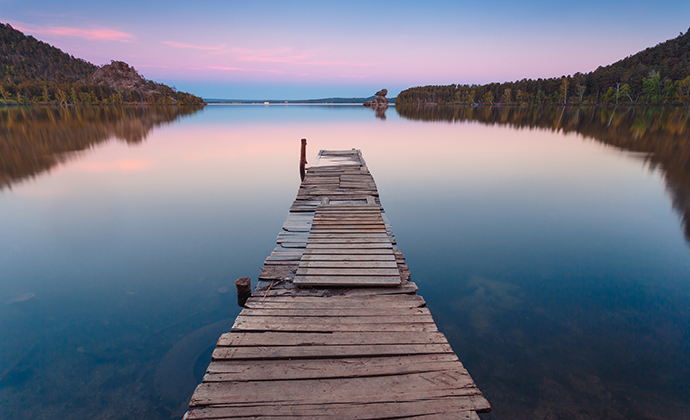
Several beautiful lakes are found in the Borovoye region © Stone36, Shutterstock
The area already attracts large numbers of domestic tourists and visitors from those parts of Russia abutting the Kazakhstani border, but there are ambitious plans to develop tourism further given Borovoye’s location as the natural weekend playground for Astana residents. (There are few other obvious tourism options within reasonable distance of the capital.) Since April 2007, the district in which Borovoye is located has been one of only two (the other is Lake Kapchagai) in Kazakhstan in which gambling establishments have been permitted, as the authorities seek to move Kazakhstan’s casinos out of the cities and into new purpose-built resorts. Given that the distinctive landscape of this region covers a relatively small territory, it must be hoped that any future development plans take account of Borovoye’s fragile environment. Some new buildings already give rise to concerns on this score. In addition, the planned Burabay Golf Resort will effectively block public access to large sections of Lake Schuche; a ski jump, under construction at the time of research, risks further commercialising the area.
Charyn Canyon
The fast-flowing Charyn River, a tributary of the Ile, forms an attractive canyon some 80km in length during its northward journey from its headwaters in the Tian Shan Mountains across the arid semi-desert east of Almaty. The depth of the canyon reaches as much as 300m where it cuts through the Toraigyr Mountains on its journey. Tour operators bill Charyn as a miniature version of the Grand Canyon. To get here, take the main road east from Almaty, through the small town of Chilik. Around 190km east of Almaty, turn left on to a signposted track. You reach the canyon after a further 9km, and having passed a checkpoint at which a small fee is taken for your entry into the Charyn National Nature Park. From the parking area here, a path heads down into the canyon. Another path, 1km to the north, is steeper but more picturesque. Almaty-based tour operators offer lengthy day trips to the canyon, sometimes combining it with the Kolsai Lakes. The Charyn River offers some challenging white-water rafting and canoeing. It is also home to a fish endemic to the region, sporting the rather picturesque name of the naked osman.
The place the tour groups head for in this part of the canyon is a dry side ravine known as the Red Canyon or Valley of the Castles. Some 3km long, and up to 100m deep, with a path running along its base, the red sandstone walls of this gorge offer natural sculptures of dramatic form. You will bake here at the height of summer: spring and autumn are ideal times to visit the canyon.
The canyons of Charyn National Nature Park are 300m deep in parts © Pikoso.kz, Shutterstock
Downstream from this part of the canyon is a remnant of a great forest of Sogdian ash that stretched across this area after the last Ice Age. The ribbon of relict forest that has survived is a 25km stretch, sheltered by the canyon. A nature reserve was established here in 1964 to help protect the grove, one of the few large populations of Sogdian ash found anywhere in the world, and this now forms a specially protected area within the Charyn National Park. It is reached via a different road from that for the Valley of the Castles: coming from Almaty turn left on the road towards Shonzhy and Zharkent a few kilometres southeast of the village of Kokpek. Other trees found in the dense patches of forest along the banks of the river include willow, poplar and barberry.
Some scholars believe that the name of the river comes from the Uyghur word ‘Sharyn’, meaning ‘ash tree’. Others suggest that it derives from the Turkic root ‘Char’, which suggests a precipice. The two options are rather fitting, since precipices and ash trees are two of the key components that make Charyn such a fascinating place.
Mangistau region
The desert scenery of the Mangistau hinterland is stunning, with white limestone escarpments and isolated mountains rising up from the plains. Aktau becomes a cheerful beach resort in summer, with plans under way to turn Kendirli in the south of the region into a major resort destination.
Shakpak Ata is the site of one of several underground mosques in the Mangistau Region © Valeria Bolotova CC-BY
Fort Shevchenko, Mangistau’s oldest town, was the place of exile of Ukrainian poet Taras Shevchenko. And the necropolises and underground mosques that dot Mangistau Region are among the most arresting of all Kazakhstan’s historical monuments.
Shakpak Ata
Shakpak Ata is the most architecturally impressive of the underground mosques of Mangistau Region: it is a fascinating site that deserves to be much better known. Continuing eastwards on the road running between Fort Shevchenko and Taushik, beyond the turning to Sultan Epe, you reach after a further 7km a crossroads, where a rougher track crosses the road. The track to the left is signposted to Shakpak Ata. Take this. After 3km, the striking dry-floored Kapamsai canyon comes into view to the right of the road. This is a limestone canyon with dramatic overhanging walls. The track takes you down a steep descent towards the coast to the side of this canyon. At the base of this descent, another 3km on, turn right where the track forks. After a further 5km is a modern domed building. This place, built in honour of a local figure named Erzhan Haziret, celebrated for his spirituality, provides basic overnight accommodation (sleeping on the floor) for pilgrims visiting the Shakpak Ata site. There is a one-roomed museum within the building, containing items of clothing worn by Erzhan Haziret as well as, usefully, floor plans of Shakpak Ata and other underground mosques in the region.
Turn right immediately beyond this building, on to a track that runs into the broad canyon in which lies the necropolis of Shakpak Ata, a few hundred metres away. On the side of the canyon, to your left, is the underground Mosque of Shakpak Ata, dated according to the plaque here to sometime between the 10th and 13th centuries. The rock forming the side of the canyon has taken a honeycomb form here, a result of wind erosion. Into the rock are cut several rectangular niches, places of burial. Firestones, shiraktases, stand in front of these. There is a niched arched portal, covered with etchings of horses, handprints and inscriptions in Arabic. You enter the mosque through a wooden door close to the portal, then climb a few rough steps.
The plan of the mosque, strikingly, takes the form of a cross. The square central space rises to a domed ceiling with a hole in the top for light and ventilation. At each corner of the space is a column, with graceful, flat arches running between them. At the centre of this space was another shiraktas when I visited, though this resulted in comments from other visitors that no pilgrim would make such a fire in a mosque – its rightful place was at a graveside – and the suggestion that the shiraktas may have been placed there by a film company, for effect. The chamber to the south has a niched mihrab, with further niches around it. The chamber to the east of the central space is much longer than the others, with further niches along its walls, possibly for books. The walls of the mosque are further enlivened by small holes into which lamps would have been placed, by numerous Arabic inscriptions, and by etched drawings of horses, goats and handprints.
At the end of the longer eastern chamber is a second entrance to the mosque, a flight of steps that brings you up on to the plateau on the side of the canyon. A modern, square-based building with a metal roof has been placed above the roof over the central chamber: while a conservation measure, the structure detracts from the natural beauty of the site. Near this building, cut into the limestone plateau, are two lines of nine egg-shaped indentations: this was a board for the game togyzkumalak.
Beyond the necropolis, the white walls of the canyon, and tamarisk bushes in the valley floor, make for some enticing scenery. You may see flints here: shakpak, in Kazakh, means ‘flint’.
Mausoleum of Aisha Bibi
The beautiful Karakhanid Mausoleum of Aisha Bibi is one place you should definitely see as part of any visit to Zhambyl Region. It sits in the village of the same name, west of Taraz. To get here, take the main road out of Taraz towards Shymkent (or hire a taxi for approximately T2,000 one-way). Aisha Bibi village lies 8km beyond the western gateway to the city. Within the village, take the signposted left turn to the mausoleum, turning left again (also signposted) where the road forks. The mausoleum is about 500m from the main road. It sits in a fenced compound amid grounds filled with red rose bushes, making this a delightful spot in season.
The Mausoleum of Aisha Bibi, the larger of the two Karakhanid buildings in the compound, is a heavily, but finely, restored square-based building, originally dating from the 11th or 12th century, with a conical roof. The external decoration is stunning: every spare piece of wall is covered with carved terracotta in a wide range of geometric designs. It is the only monument in central Asia fully covered with carved terracotta tilework. The main entrance is on the eastern side of the building, set in a niche. Niches on the other three walls enclose latticed wooden windows. There is a cloth-covered tomb inside.
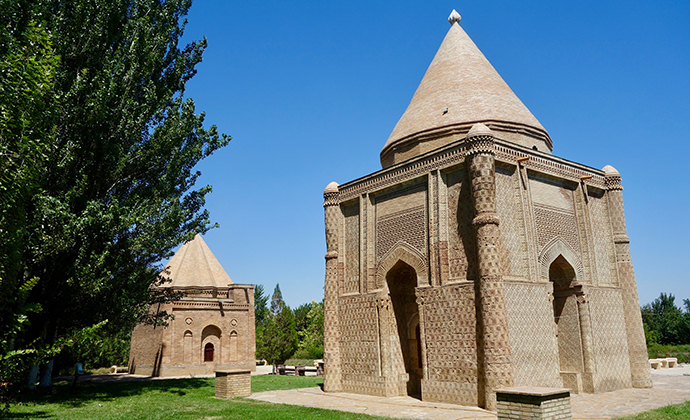
The exquisitely decorated mausoleum dates back to the 11th or 12th century © Maria Oleynik
Aisha Bibi is the subject of a popular legend in Kazakhstan. While there are numerous variations of the story, it runs broadly as follows. Aisha, of a well-todo 11th-century family and a descendant of the Prophet, was brought up by her stepfather, Zangi-Ata. The Governor of Taraz, Shakhmakhmud, fell in love with her, and asked for her hand in marriage. This was rejected by Zangi-Ata, since Shakhmakhmud did not have Aisha’s distinguished lineage. Aisha defied her stepfather and rode for Taraz to be united with the man she loved, but just short of the city she was bitten by a snake and died. The distraught Shakhmakhmud, who is also known as Karakhan Bab, built this beautiful mausoleum at her place of death. Shakhmakhmud never married, and became a wise and benevolent ruler, receiving the informal title of ‘holy father’, Aulie Ata. Since the monument is associated with the eternal qualities of love, and because it is a beautiful place surrounded by red roses, it is a popular spot for wedding couples to come and be photographed.
To the right stands another attractive building, the Mausoleum of Babazhi Khatun. This is a 12th-century structure that has also been heavily restored. It has a distinctive ‘corrugated’ conical dome, with 16 sharp-edged ridges radiating out from the top, looking rather like a hat made in a school origami class. The external walls are plainer than those of the Aisha Bibi Mausoleum, though an Arabic inscription runs across the top of the eastern facade, above the arched entrance. There is no tomb inside the building. Babazhi Khatun is popularly believed to be the friend or nanny of Aisha Bibi, who faithfully tended the latter’s mausoleum after her death, and was buried nearby.
Oral
The capital of West Kazakhstan Region, the city of Oral (known in Russian as Uralsk) is one of the most historically interesting in Kazakhstan, though you do have to search hard among the Soviet concrete to find the remnants of this heritage. It was a centre of the Pugachev Rebellion in the 1770s, and takes pride in its status as the only city of Kazakhstan to have been visited by the Russian poet Pushkin. With some fine Tsarist architecture, it makes a good place for a short stopover.
Oral is often still known by its Russian name of Uralsk © ArsenG
Established by Cossacks in 1584 at the confluence of two rivers, the Ural, then called the Yaik, and the Chagan, the town of Oral, originally named Yaitskiy Gorodok, claims its formal year of foundation as 1613. Because of the prominent role played by the town in the Pugachev Rebellion, Empress Catherine the Great determined on the defeat of the rebellion that she would obliterate the name of Yaitskiy Gorodok from the map, and with it the memory of Pugachev. By a decree of 15 January 1775, she determined that the Yaik River would be renamed Ural, that the Yaitsk Cossack Host would henceforth be known as the Uralsk Cossack Host, and that the town would now be called Uralsk.
Under its new name, the town flourished. As it expanded northwards from its original core, smart new brick buildings appeared. It was the scene of considerable fighting during the Russian Civil War. The celebrated Red Army commander Vasily Chapaev was killed south of here, near the settlement now renamed Chapaev in his honour, while attempting to swim across the Ural River to escape White Army forces. A number of industrial enterprises, such as the Zenit weapons factory from Leningrad, were relocated here during World War II from more vulnerable cities further to the west, further promoting the growth of the town. The discovery of a major oil and gas condensate deposit at Karachaganak near Aksai in the eastern part of the region in the late 1970s provided a further significant boost for the economic development of Uralsk and its surrounding region. Uralsk had become the administrative capital of the West Kazakhstan Region when the latter was formed in 1932. This was renamed as Uralsk Region in 1962, but reverted to its original name in 1992. While the city is officially now known by its Kazakhised name, Oral, Uralsk is still widely used.
Turkestan
Lying between Kyzylorda and Shymkent, the Silk Road town of Turkestan (Turkistan in Kazakh) contains Kazakhstan’s most impressive monument and most important pilgrimage site, the Timurid Mausoleum of Khoja Ahmed Yassaui. The town celebrated somewhat arbitrarily in 2001 its 1,500th anniversary. Its origins lie in the settlement of Shavgar, which flourished in the 9th and 10th centuries as a centre for trade and handicraft production. Shavgar appears to have declined in the 12th century, in favour of Yassi, which was probably initially a suburb or satellite town. Yassi’s fortunes in turn were linked to the presence here of a revered Sufi mystic, Khoja Ahmed Yassaui, and became a place of pilgrimage on his death.
The town grew further in importance following a visit to Yassaui’s decaying grave by Timur, known in the West as Tamerlane, in 1397. Timur ordered the construction of a magnificent new monument befitting a saint of Yassaui’s stature: a multi-functional building that would incorporate a vast and ornate mausoleum. His motivation was probably in part philanthropic, but in part also to help promote his rule in the area. Detailed designs were drawn up, and arrangements were also put in place for the funding, through voluntary donations, of a staff comprising a preacher, two Koran readers, a property manager, water carrier, gardener and, mysteriously, a scavenger. Construction began in 1399, but the building was left unfinished on Timur’s death in 1405. The main portal and some of the interiors remain today in an incomplete state, but the building still attains a great beauty through its size, turquoise domes and stunning decorated tilework.
Turkestan’s Khoja Ahmed Yassaui Mausoleum is without doubt Kazakhstan’s finest building © Maria Oleynik
Details of the life of the man on whom Turkestan’s importance is based are relatively sketchy. Khoja Ahmed Yassaui was born in Sayram, at that time known as Ispijab, probably around 1103. His father, Sheikh Ibragim, was a well-known local figure, but Ahmed was orphaned at the age of seven, and he moved to Yassi with his elder sister, his only remaining close relative. His teacher was the venerable Arystan Bab, also known as Arslan Bab (both names meaning ‘lion’), according to legend a former companion of the Prophet Muhammad. On the death of Arystan Bab, Ahmed moved to Bukhara, where he became a disciple of Sheikh Yusup Hamadani, an important figure in the development of Sufism in central Asia. Ahmed elected to return to Yassi, taking the name Ahmed Yassaui, becoming a highly successful propagator of Islam, based around a mystic Sufi tradition. He used the local Turkic language in his religious poetry, which made it accessible to ordinary people, and it proved hugely popular. The poetry was much later collected in a book, Divan-i Hikmet, the authenticity of which is doubtful. When Yassaui attained the age of 63, that reached by the Prophet Muhammad, he retired to an underground cell, where he lived in prayer and contemplation, explaining that he had no wish to live a worldly life longer than that of the Prophet.
Between the 16th and 18th centuries Yassi, which became known as Turkestan, became a capital of the Kazakh Khanate. The Kazakh leaders chose Turkestan in large measure because of the spiritual significance of the town; allowing them to claim the Islamic heritage of Khoja Ahmed Yassaui, as well as at least part of the legacy of Timur. Many Kazakh khans and other senior figures were buried here, reflecting the traditional belief that burial close to the grave of a saint would provide protection in the next world. Among the first burials here linked with the khanate was that in 1519 of Amanbike, daughter of Janybek, co-founder of the Kazakh Khanate. The city was also the scene of ceremonies of the elevation of Kazakh khans to their throne, among them that of Ablai Khan in 1771. By tradition the act of coronation involved lifting up the new khan on a white felt mat.
In the late 19th century, during the Russian conquest of central Asia, one of Russia’s most celebrated painters, Vasily Vereshchagin, served at the court of Konstantin Petrovich von Kaufmann, the first Governor-General of Russian Turkestan. Vereshchagin spent several years in the region producing a fine collection of paintings entitled the ‘Turkestan Series’. On display in Moscow in the State Tretyakov Gallery, these offer an insight into the everyday life of the region and its people amid Russia’s military campaigns.
Turkestan today is a major Sufi pilgrimage centre. By local tradition, three pilgrimages here are considered to equate to one to Mecca, and pilgrims far outnumber tourists. The town also houses the Kazakh–Turkish University named, of course, in honour of Yassaui.
Ulytau Mountains
Ulytau, the ‘Great Mountains’, rise up from the surrounding steppe some 130km to the northwest of Zhezkazgan. This ancient granite massif is not particularly high: its highest peak, bearing the name White Mosque, reaches a height of 1,131m. But this range, located at the geographical centre of Kazakhstan, has a place at the heart of the development of the Kazakh people. The mountains of Ulytau and the steppes that surround them are full of historical monuments: petroglyphs, barrows adorned with curious stone ‘moustaches’, and numerous mausolea. It is difficult to separate out the facts from the legends surrounding the area. On the peaks of the mountains here, they say, are buried Tokhtamysh, the great rival of Timur, and Edigey, the Emir of the White Horde who, as an ally of Timur, killed Tokhtamysh in 1406. Mausolea are ascribed to Alasha Khan, the legendary founder of the Kazakh people, and Jochi, son of Genghis Khan. The Kazakh tribes came together close to the Ulytau Mountains to inflict, in 1727, a crucial defeat on the invading Dzhungars at Bulanty to the southwest. It is said that many Kazakh khans were crowned here, a ceremony that involved being raised aloft on a white felt rug. Well-to-do Kazakhs come to these mountains to spend time in an environment considered to be particularly favoured for its cosmic energy, and to eat mutton from local sheep, its taste highly regarded because the local ovine diet is so strong in highly aromatic wormwood. It is no surprise that a Kazakh band aiming to create a sound fusing rock music with the strains of traditional Kazakh instruments should choose Ulytau as its name.
Ulytau is home to several mausolea, including that of Alasha Khan, the legendary founder of the Kazakh people © Yerlan Karin CC-BY
While there are plans to encourage tourism development in the area, there is as yet very little in the way of tourist infrastructure. A couple of buses a day make the journey from Zhezkazgan to the village of Ulytau, but to get to most of the historical sights you’ll either need your own transport, or to come to a deal with a taxi driver in Zhezkazgan.
Related books
For more information see our guide to Kazakhstan:
Related articles
Read more about Kazakhstan through our articles below and also by checking out this guide on what to eat in Kazakhstan and this collection of interesting facts about Kazakhstan.
Discover our favourite sights along one of the most important trading routes in history.
Exploring one of our favourite regions with our Photographer of the Month, Cynthia Bil.
The Kazakh capital is packed with architectural delights.
Looking for an off-the-beaten-track ski holiday? Then this Kazakh resort is for you.
Discover what not to miss on a visit to Almaty with our walking tour of the city.
